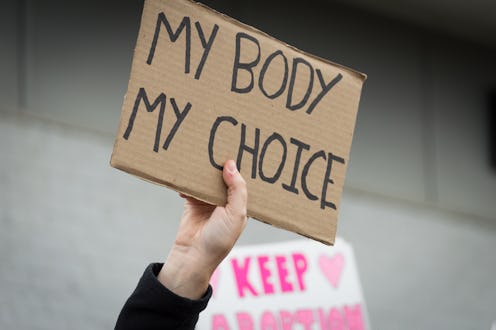News
Proof the "War on Women" Continues

Given the outcomes of two recent Supreme Court decisions that have dramatically altered the landscape of reproductive rights in America, it would be rather misleading to declare the end of the "War on Women." After all, over the last two weeks, buffer zones outside abortion clinics in Massachusetts, Maine, Vermont, and Wisconsin have vanished, while more for-profit companies are taking legal action against providing birth control to their female employees. But there is one potential bright spot: A new study found that states have passed the lowest number of abortion restrictions in recent years.
The study, conducted by the Guttmacher Institute, found that 13 states have enacted just 21 laws restricting abortion access during the first half of 2014. Though this number may have sounded high 10 or 20 years ago, it's actually remarkably low compared to the last three years — when the "War on Women" was just getting started.
According to Guttmacher, 81 abortion restrictions were enacted by this time in 2011; in 2012, that number dropped to 39, then rose slightly to 41 in 2013. This year has also seen fewer abortion restrictions than 2010, which had 26 restrictions enacted by the midpoint.
The researchers say there's a few simple explanations for the decrease in abortion restrictions. For one, several anti-choice state legislatures, such as Texas and North Dakota, are not in session during even-numbered years, while others had shortened legislative periods in 2014.
Many state lawmakers also chose to focus on issues other than abortion so far in 2014. Some of these issues distracting state leaders from abortion are the Affordable Care Act, Medicaid benefits, and drug initiatives triggered by the rising heroin epidemic.
But there's another side to these numbers: Are fewer abortion restrictions being passed because the measures in place are already working? According to Guttmacher, it's yes and no.
The institute predicts we'll be seeing fewer laws banning abortion at either 20 weeks last menstrual period (the medical way to date a pregnancy) or post-fertilization because these laws haven't been working out so well in the courts. For example, Arizona's 20-week ban was struck down in a lower court in 2013. The Supreme Court declined to take it up for review in early January, letting the lower court's decision stand.
States seem to have slowed down on passing similar measures, with only Mississippi enacting a 20-week ban in 2014. Of course, it's not like 20-week bans aren't still a problem — 10 states currently prohibit abortion at 20 weeks after fertilization, or 22 weeks from a woman's last menstrual period. According to Guttmacher, 19 percent of American women are affected by this type of ban.
Second-trimester abortion bans may be on their way out of state legislatures, but what's troubling is the rise in Targeted Regulation of Abortion Providers laws (also known as TRAP laws). They are exactly what they sound: laws that trap abortion providers by blocking their clinics with burdensome regulations ranging from mandating the width of hallways to licensing schemes and unannounced, warrantless searches.
According to Guttmacher, 26 states have some sort of TRAP law in place, compared to just 11 states in 2000. Since 2011, many of these laws have worked as backdoor abortion bans — never directly outlawing the procedure, which would be unconstitutional, but making it so it's extremely tough for women to receive an abortion. TRAP laws have helped shutter abortion clinics in a number of Midwestern or Southeastern states, including Mississippi, Alabama, Texas, and North Dakota.
State restrictions on abortion may not be happening as quickly as they were, but perhaps states don't need to pass them anymore: When a state only has one or two clinics left, then you know these laws are working. For the 55 percent of American women affected by these TRAP laws, that is a terrifying reality.
Images: Steve Rainwater/Flickr, Getty Images